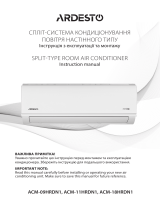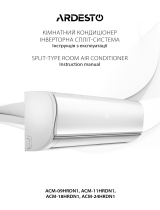
2. Names and Operations
8
(EN)
REMOTE CONTROLLER
One remote controller can control a group of
up to eight indoor units. (See page 17)
1. Operation Display
Displays the operation status.
(The fi gure shows all the
statuses.)
• The auto-fl ap display may be
different, depending on the
installed unit. (See page 16.)
2. Start/Stop button
Pressing this button once starts
and pressing again stops the
operation.
3. Fan speed button
4. Swing/Wind Direction button
5. Timer setting button
Use for operating with a timer.
6. Reset button
Use this button after changing the
batteries.
7. Cover
Press at the top center and then
slide down.
8. Transmitter
9. Remote control sensor
Detects the temperature at the
remote controller when detection
has been switched to the remote
controller by the sensor button.
10. Temperature setting buttons
raises the temperature
setting 1 °C at a time.
lowers the temperature
setting 1 °C at a time.
11. Filter button
CZ-RWSC3
Press to turn off the fi lter lamp on
the receiver.
12. Mode Select button
Press to switch the operation
mode.
13. Ventilation button
Use this when connected to an
aftermarket fan. Pressing this
button starts and stops the fan.
When the air conditioner is started
or stopped, the fan starts or stops
at the same time. ( appears on
the display of the remote
controller when the fan is
operating.)
14. Address button
15. Sensor button
Used this to activate the
temperature sensor on the remote
controller instead of the one on
the indoor unit. The temperature
sensor on the indoor unit is
selected before shipment. At this
time
is shown on the display.
16. Clock button
Use this to set the clock.
From this page, the names of
remote controller’s buttons will be
indicated with the above
illustrations.
E.g.: Start/Stop button

























